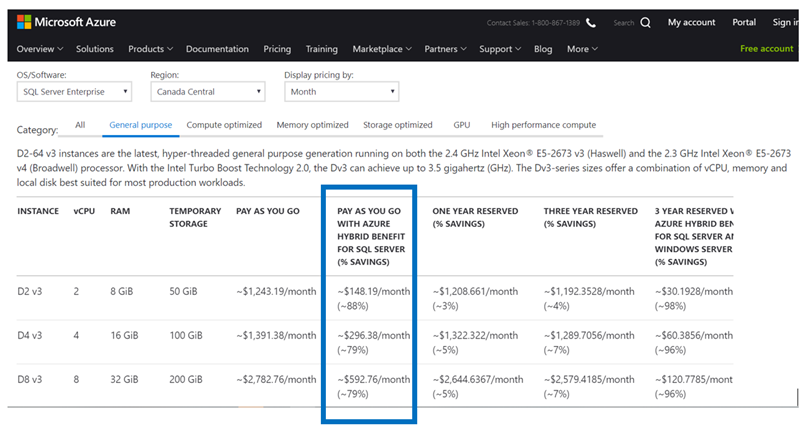BYOL SQL & Windows Server license to the Cloud: Azure Hybrid Benefit (AHB) vs License Mobility. What is the difference?
When an organization deploys a solution built on the Microsoft platform to the Cloud, there are three options in regards to licensing the required Microsoft Server products:
- Option One: Organizations can purchase cloud services that include the required server products (e.g. a fully loaded Windows Server virtual machine).
- Option Two (BYOL): Organizations can purchase prepaid SQL/Windows Server subscriptions (1 or 3-year terms available), currently offered through Microsoft’s CSP program.
- Option Three (BYOL): Customers with active Software Assurance can bring their own SQL/Windows Server licenses to the Cloud.
Options 2 and 3 are what we call Bring Your Own License scenario (BYOL), and they provide better TCO in most of the cases. For example, by bringing SQL Server, Windows Server licenses to Azure organizations can realize significant savings in Azure.
The table below compares BYOL scenario vs buying SQL Server Enterprise license as a part of Pay As You Go Azure Virtual Machine subscription (please find the detailed view here): 
The rules of BYOL are different for Microsoft Cloud (Azure) and other Clouds. The BYOL programs for Azure and other cloud providers also have different names. For other cloud providers program name is License Mobility because it actually allows moving licenses between on premises datacenter and the cloud provider. For Azure the BYOL program name is Azure Hybrid Benefit (AHB), and it is an extension of License Mobility offer.
Key requirement to leverage AHB or License mobility offers is an active Software Assurance for the server product or an active server product subscription.
The tables below summarize the key difference between AHB and Licenses Mobility for SQL Server and Windows Server.
SQL Server
| Cloud type: | Microsoft Azure | Other Clouds (GCP, AWS, other hosting providers*) |
| Offer name: | Azure Hybrid Benefit | License Mobility |
| IAAS scenario:
BYOL to a Virtual Machine (VM) in the Cloud |
1 SQL Server ENT/STD Core license provides the rights to run 1 vCore in the Azure VM.
Each VM in the Cloud should have at least 4 SQL Server Core Licenses assigned. For example, if you have only 2 vCore VM you still need to ssign 4 SQL Server Core licenses to this VM. |
[The same as for Azure Hybrid Benefit] 1 SQL Server ENT/STD Core license provides the rights to run 1 vCore in the Cloud VM.
Each VM in the Cloud should have at least 4 SQL Server Core Licenses assigned. For example, if you have only 2 vCore VM you still need to assign 4 SQL Server Core licenses to this VM. |
| PAAS scenario:
BYOL to a SQL Server Managed Service (sharedinfrastructure) |
Yes, organization can bring SQL Server licenses with active SA to Azure SQL Managed Instance.If you have Enterprise Edition per core licenses, you can get 4 vCores in the Azure SQL Managed Instance General-Purpose Tier for every SQL license core you own on-premises. This is a unique benefit available only on Azure.If you have Standard Edition per core licenses with Software Assurance, you can get one vCore in the general-purpose tier for every SQL Server license core youown on-premises. | No, BYOL SQL Server license scenario is not available for Managed services such as AWS RDS and others. |
| Can we use our SQL Server license on-premises AND in the cloudsimultaneously? | No, your SQL Server licenses must be used either on-premises OR in Azure.
However, you have a 180-day grace period during which you can use licenses both on-premises and in the cloud to facilitate migration. |
No, your SQL Server licenses must be used either on-premises OR in the cloud. |
Windows Server
| Cloud type: | Microsoft Azure | Other Clouds (GCP, AWS, other hosting providers *) |
| Offer name: | Azure Hybrid Benefit | License Mobility |
| IAAS scenario: BYOL to a Virtual Machine in the Cloud | Azure Hybrid benefit is available for Windows Server.
For virtual machines running 24x7 this option provides significant savings compared with buying SQL Server subscription along with VM. |
No License Mobility (BYOL) for Windows Server**. The Windows Server license subscription can be acquired along with VM from the cloud provider. |
| Can our Windows Server license be used on premises AND in the cloud simultaneously? | The Azure Hybrid Benefit for Windows Server Standard Edition licenses can only be used once either on-premises OR in Azure.
Windows Server Datacenter Edition benefits allow for simultaneous usage bothon-premises AND in Azure. Each 2-processor license or each set of 16-core licenses are entitled to two instances of up to 8 cores, or one instance of up to 16cores. |
No License Mobility (BYOL). |
The differences between Azure Hybrid benefits and License Mobility listed above are one of the reasons why Azure is the most cost-effective cloud for Windows Server and SQL Server. ![clip_image005[7] clip_image005[7]](https://msdntnarchive.z22.web.core.windows.net/media/2019/03/clip_image0057_thumb.png)
If you are interested to learn more about SQL Server licensing please watch this webinar: Demystifying SQL Server 2017 and How to Buy.
I want to say Big Thank you to Jai Dhir, Microsoft Licensing Manager for reviewing the blogpost and providing valuable feedback. Please let me know if you have any comments, questions or feedback by sending email to CanadaDataPlatform@microsoft.com
_______________________
* please find the list of Authorized Mobility Partners here
** Windows Server is not eligible for License Mobility through Software Assurance, please find the details here
This blogpost is for information purposes only, for the official Microsoft documentation on Azure Hybrid Benefit and License Mobility please check these links: